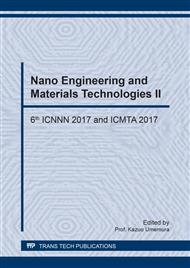p.74
p.79
p.85
p.91
p.96
p.101
p.107
p.115
p.120
Morphology Induced Effect on the Electrochemical Activity of Cobaltous Oxide Nanostructures in Potassium Hydroxide and Phosphoric Acid Media
Abstract:
The morphology of cobalt oxide / cobaltous oxide (Co3O4) nanostructures was controlled using different seed layer concentrations and deposition time. Co3O4 nanostructures were deposited on ITO glass synthesized using two step solution route. The morphological evolution of the Co3O4 nanostructures has been investigated using scanning electron microscopy (SEM). This has been correlated to the electrochemical activity of the material using cyclic voltammetry (CV) in a potassium hydroxide (KOH) and phosphoric acid (H3PO4) media. Other characterization technique such as x-ray diffraction analysis (XRD) was used to verify the crystal structures of the Co3O4 nanostructures. The Co3O4 nanostructures revealed pronounced redox peaks in a 1M KOH electrolyte which proved its high electrochemical activity. Also the redox peaks increases with the increase in scan rate which demonstrated good reversibility of a fast charge-discharge response. Varying CV curves have been observed in a 1M H3PO4 electrolyte which denotes the instability of Co3O4. The change in the morphology of Co3O4 certainly affects the electrochemical property of the Co3O4. This leads to an advance study for its promising electrochemical applications for a cleaner energy.
Info:
Periodical:
Pages:
96-100
Citation:
Online since:
March 2018
Keywords:
Price:
Сopyright:
© 2018 Trans Tech Publications Ltd. All Rights Reserved
Share:
Citation:


